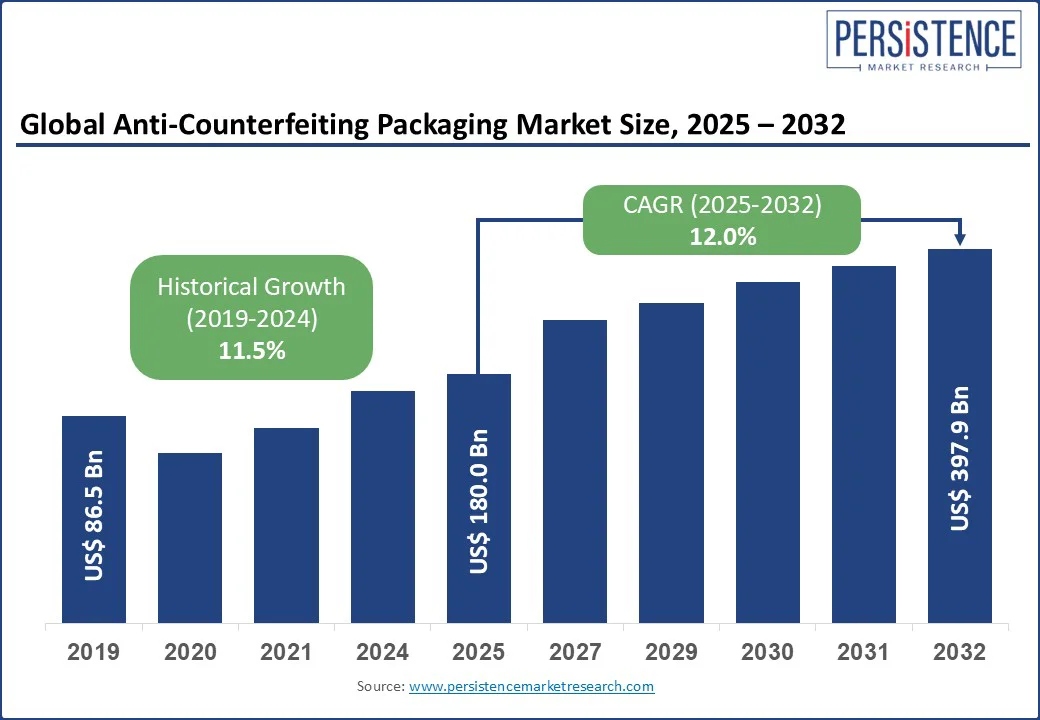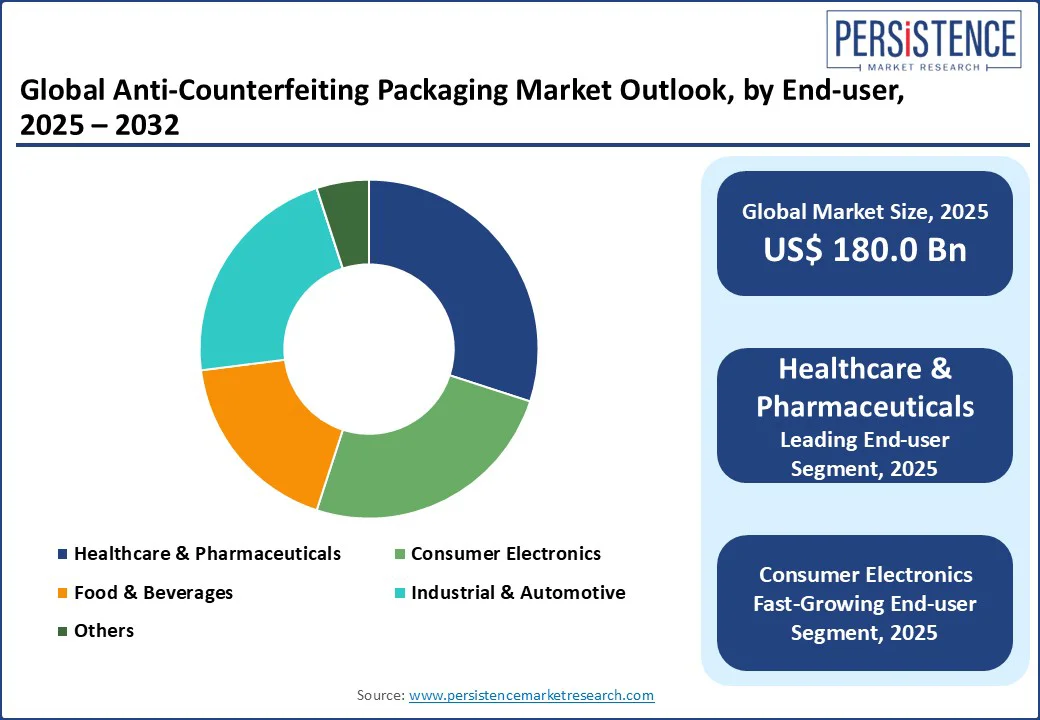ID: PMRREP3320| 214 Pages | 13 Aug 2025 | Format: PDF, Excel, PPT* | Packaging

The global Anti-Counterfeiting Packaging Market size is likely to be valued at US$ 180.0 Bn in 2025 and is expected to reach US$ 397.9 Bn by 2032, growing at a CAGR of 12.0% from 2025 to 2032.
This growth is driven by the rising incidence of counterfeit goods, stringent regulatory requirements, and advancements in anti-counterfeiting technologies such as RFID, holograms, barcodes, and other innovative solutions.

Key Industry Highlights
|
Global Market Attribute |
Key Insights |
|
Anti-Counterfeiting Packaging Market Size (2025E) |
US$ 180.0 Bn |
|
Market Value Forecast (2032F) |
US$ 379.9 Bn |
|
Projected Growth (CAGR 2025 to 2032) |
12.0% |
|
Historical Market Growth (CAGR 2019 to 2024) |
11.5% |
The rising threat of counterfeit goods is a major driver of the anti-counterfeiting packaging market, particularly across high-risk sectors such as pharmaceuticals, electronics, and luxury products. According to the OECD, global trade in counterfeit goods represented approximately 2.3% of world imports, highlighting the urgent need for secure packaging solutions.
The problem is especially severe in healthcare, where counterfeit medicines endanger lives and undermine trust. To combat this, governments have implemented strict regulations, such as the FDA’s Drug Supply Chain Security Act (DSCSA) in the U.S., which mandates serialization and electronic traceability of prescription drugs.
In addition, the EU’s Falsified Medicines Directive requires tamper-evident features and unique identifiers on pharmaceutical packaging. These global mandates, along with growing consumer awareness and the proliferation of e-commerce, are accelerating the adoption of technologies such as QR codes, RFID tags, and track-and-trace systems, strengthening the anti-counterfeiting packaging market for anti-counterfeiting packaging solutions.
The high cost of implementing advanced anti-counterfeiting technologies is a significant restraint. Technologies such as RFID and blockchain require substantial investments in infrastructure, software integration, and training. A 2024 report estimated that RFID systems increase packaging costs by 12-18% compared to traditional barcodes, posing challenges for small and medium-sized enterprises (SMEs) with limited budgets.
Integration into existing supply chains is complex, particularly for companies with legacy systems, leading to delays and additional expenses. For instance, blockchain-based tracking systems require interoperability across stakeholders, which can cost up to 20% more than conventional solutions.
In developing regions, where cost-effective solutions such as barcodes remain prevalent, the adoption of advanced technologies is slower. The need for continuous updates to counter evolving counterfeiting techniques further increases costs, with maintenance expenses rising by 10% annually for RFID systems. Consumer skepticism about synthetic or complex packaging solutions, coupled with limited awareness in some markets, also hampers adoption, particularly among smaller players.
Technological advancements in blockchain and smart packaging present significant growth opportunities. Blockchain-based systems offer transparent, tamper-proof supply chain tracking, enabling real-time verification of product authenticity. A 2024 report highlighted a 20% increase in blockchain adoption in pharmaceuticals, with companies such as Merck collaborating with tech firms to develop digital twin solutions.
Smart packaging, incorporating NFC tags and sensors, allows monitoring of tampering and environmental conditions, particularly in healthcare and food sectors. For example, ExxonMobil’s 2023 launch of QR-code-based anti-counterfeit features for lubricant packaging enhanced consumer verification capabilities.
These innovations enable product differentiation and premiumization, creating opportunities in high-growth markets such as Asia Pacific, where e-commerce and regulatory compliance are rising. The global smart packaging market is projected to grow rapidly, driven by demand for interactive and secure solutions. Government initiatives, such as India’s push for QR code-based tracking, further support the adoption of smart packaging, offering manufacturers a chance to capture premium market segments.
Track and Trace technology leads the anti-counterfeit packaging market, accounting for approximately 40% of the market share. Its dominance is driven by widespread adoption in pharmaceutical, food & beverage, and consumer goods industries, where serialization, barcode scanning, and RFID tracking ensure product authenticity and supply chain visibility. Growing regulatory mandates, such as the FDA’s DSCSA and the EU Falsified Medicines Directive, further accelerate adoption.
Tamper-evident packaging is the fastest-growing segment, fueled by rising demand for visible indicators of package integrity. Solutions such as tamper-proof seals, films, and security labels are increasingly used to safeguard products against counterfeiting-especially in sectors where consumer trust and safety are critical.
Bottles and Jars remain the dominant packaging type, holding approximately 30% market share in the anti-counterfeit packaging market, widely used in pharmaceuticals, personal care, and nutraceuticals. Their durable structure allows for easy integration of RFID tags, QR codes, security labels, and tamper-evident seals, providing enhanced protection and traceability. These formats are preferred for high-value liquids, capsules, and creams where product integrity is critical.
Labels and Tags are the fastest-growing segment, driven by increasing demand for cost-effective, scalable, and technology-enabled authentication solutions. Applied across multiple packaging formats, smart labels and tags can incorporate barcodes, holograms, serial numbers, and covert markers, making them a flexible option for track-and-trace systems.
As regulations tighten and counterfeiting threats rise-especially in e-commerce and global logistics-the use of intelligent labeling is accelerating, offering real-time product verification and boosting consumer confidence in both healthcare and consumer goods sectors.
Healthcare and Pharmaceuticals dominate the anti-counterfeit packaging market, holding around 30% of the global market share. This leadership is driven by the industry's high vulnerability to counterfeit drugs and strict global regulations.
Laws such as the FDA’s Drug Supply Chain Security Act (DSCSA) and the EU Falsified Medicines Directive mandate serialization, tamper-evident packaging, and track-and-trace solutions, increasing demand for RFID, 2D barcodes, and security labels in pharmaceutical packaging. The need to ensure drug authenticity, patient safety, and supply chain transparency makes secure packaging essential in this sector.
Consumer Electronics is the fastest-growing end-use segment, driven by the booming e-commerce sector and rising incidents of product counterfeiting. High-value electronic items such as smartphones, gadgets, and accessories are increasingly secured with smart packaging technologies, including QR codes, holograms, and covert authentication features, helping brands protect their reputation and enhance product traceability and consumer trust.

North America dominates the anti-counterfeit packaging market, holding around 40% of global share, driven by stringent regulatory compliance, technological advancements, and growing demand for product authenticity. The United States, with over 70% of the regional share, leads due to its strong pharmaceutical and consumer electronics industries.
Implementation of the FDA’s DSCSA has accelerated the adoption of RFID and barcode-based track-and-trace solutions. Companies such as Avery Dennison are innovating in smart labeling technologies. In Canada, rising demand for tamper-evident packaging in the food and pharma sectors, backed by regulatory pressure and consumer awareness, continues to support regional market expansion.
Europe holds a significant share in the anti-counterfeit packaging market, driven by strict regulations and rising demand for brand protection in sectors such as pharmaceuticals, automotive, and luxury goods. Germany leads the region, supported by the EU’s Falsified Medicines Directive, which boosted adoption of RFID and hologram technologies by 10% in 2024.
Companies such as Constantia Flexibles are innovating in secure packaging solutions. In the United Kingdom, growth is driven by increasing use of blockchain-based tracking in cosmetics and luxury products, with secure packaging sales rising by 11%, reflecting strong investment in advanced anti-counterfeit technologies.
Asia Pacific is the fastest-growing region in the anti-counterfeit packaging market, expanding at a CAGR of 16%, driven by rapid e-commerce growth, industrialization, and stricter regulations. China is a key contributor, with rising counterfeiting threats in consumer electronics and cosmetics. In 2024, the adoption of QR codes and holograms increased by 13%, as brands strengthen product authentication. In India, a 2023 government mandate requiring QR codes on pharmaceutical packaging led to a 14% rise in anti-counterfeit solution sales in 2024. Growing middle-class demand and improved regulatory compliance are fueling the adoption of track-and-trace and tamper-evident packaging technologies.

The Global Anti-Counterfeiting Packaging Market is competitive, with key players such as Avery Dennison, Amcor, and Berry Global leading through advanced technologies and global reach. Companies focus on R&D, acquisitions, and partnerships to enhance offerings.
Smaller players such as Alpvision and Atlantic Zeiser target niche segments with solutions such as digital watermarks and security inks. The anti-counterfeiting packaging market is characterized by rapid innovation, with firms integrating blockchain and smart packaging to stay competitive.
The Anti-Counterfeiting Packaging Market is projected to reach US$ 379.9 Bn by 2032, with a CAGR of 12.0% from 2025 to 2032.
Rising counterfeiting incidents, stringent regulations, and e-commerce growth drive demand for secure packaging solutions.
Consumer electronics is the fastest-growing segment, driven by the rising spending power of consumers.
Asia Pacific is the fastest-growing region, driven by e-commerce, industrialization, and regulatory mandates in China and India.
|
Report Attribute |
Details |
|
Historical Data/Actuals |
2019 - 2024 |
|
Forecast Period |
2025 - 2032 |
|
Market Analysis Units |
Value: US$ Bn |
|
Geographical Coverage |
|
|
Segmental Coverage |
|
|
Competitive Analysis |
|
|
Report Highlights |
|
|
Customization and Pricing |
Available upon request |
By Technology Type
By Packaging Type
By End-use
By Region
Delivery Timelines
For more information on this report and its delivery timelines please get in touch with our sales team.
About Author